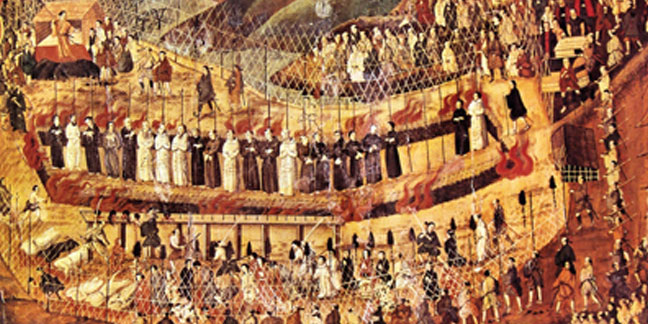 Born to a wealthy military leader in 1562 at Tounucumada, Japan, Paul Miki felt called to religious life at a young age. He became a Jesuit in 1580 and was soon widely known as a successful evangelist. In 1587, the political climate became hostile to Christianity, when the Japanese emperor became suspicious of the Catholic missionaries that had followed in St. Francis Xavier's footsteps a few decades earlier and were converting large numbers of Japanese. He accused the missionaries of "corrupting and stirring up the lower classes" and ordered them all out of the country. Miki and 25 other missionaries and laypeople, including three teenaged boys, were arrested in 1597 for disobeying his edict.
Born to a wealthy military leader in 1562 at Tounucumada, Japan, Paul Miki felt called to religious life at a young age. He became a Jesuit in 1580 and was soon widely known as a successful evangelist. In 1587, the political climate became hostile to Christianity, when the Japanese emperor became suspicious of the Catholic missionaries that had followed in St. Francis Xavier's footsteps a few decades earlier and were converting large numbers of Japanese. He accused the missionaries of "corrupting and stirring up the lower classes" and ordered them all out of the country. Miki and 25 other missionaries and laypeople, including three teenaged boys, were arrested in 1597 for disobeying his edict.
Over the next 30 days, they were forcibly marched 600 miles through the snow from Kyoto to Nagasaki so that they could be a warning to other Japanese Christians. On Feb. 5, 1597, as the group approached the hill in Nagasaki where they were to be tied to crucifixes measured especially for each of them, they all sang the Te Deum. More than 4,000 residents of Nagasaki – many of them Catholics who were crying and praying – witnessed the executions.
Miki's last sermon was delivered from the cross: "All of you who are here, please, listen to me... I have committed no crime, and the only reason why I am put to death is that I have been teaching the doctrine of Our Lord Jesus Christ. I am very happy to die for such a cause, and see my death as a great blessing from the Lord. At this critical time when, you can rest assured that I will not try to deceive you, I want to stress and make it unmistakably clear that man can find no way to salvation other than the Christian way. The Christian religion tells us to forgive our enemies and those who do harm us, and so I say that I forgive the emperor and those responsible for my death. I have no hatred for the emperor; indeed, I wish that he and all the Japanese would become Christians."
In another account of his final preaching, he was recorded as also saying, "The only reason for my being killed is that I have taught the doctrine of Christ. I thank God it is for this reason that I die. I believe that I am telling the truth before I die. I know you believe me and I want to say to you all once again: Ask Christ to help you become happy. I obey Christ. After Christ's example, I forgive my persecutors. I do not hate them. I ask God to have pity on all, and I hope my blood will fall on my fellow men as a fruitful rain."
Like his 25 companions, Miki died on the cross after being stabbed through the chest with a lance. He was just 30 years old, but he was not the youngest in the group: St. Louis Ibaraki was 12, St. Anthony was 13, and St. Thomas Kozaki was 14. St. Anthony's parents were at the foot of his cross to witness their son's bloody killing.
Persecution of Christians continued for another 300 years. Thousands of Catholic missionaries and the faithful – including their spouses and children – were imprisoned, tortured, burned alive, drowned, buried alive, hung or beheaded for the faith. More than 650 martyrs were killed on Martyrs Hill in Nagasaki alone. Japanese Christianity was driven underground until the 1860s, when European missionaries returned and found the faith still alive. In 1889, Japan constitutionally recognized freedom of religion, and in 1919 the country established diplomatic relations with the Vatican.
Miki and his 25 companions, called "The 26 Martyrs of Japan," were canonized in 1862 by Pope Pius IX, and a shrine was built on the hill in 1962.
— Sources: Catholic News Agency, Catholic Online, 26 Martyrs Museum
More online
To learn more about the day in 1597 when the 26 Martyrs were crucified and the memorial that now stands in Nagasaki, go online to www.26martyrs.com.


